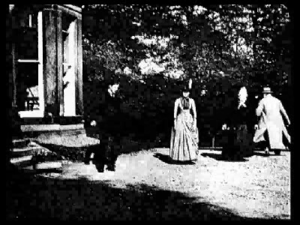Long Peace: Difference between revisions
No edit summary |
No edit summary |
||
| Line 14: | Line 14: | ||
}} | }} | ||
The '''Long Peace''' was an era of [[Estmere|Estmerish]] [[History of Estmere|history]] generally agreed to have lasted from the end of the [[War of the Triple Alliance]] in 1855 to the [[Great Collapse]] in 1913, though some historians extend the period until the beginning of the [[Kireno-Estmerish War]] in 1916. The period was named for the unprecedented peace which citizens of the Estmerish metropole enjoyed at the time, | The '''Long Peace''' was an era of [[Estmere|Estmerish]] [[History of Estmere|history]] generally agreed to have lasted from the end of the [[War of the Triple Alliance]] in 1855 to the [[Great Collapse]] in 1913, though some historians extend the period until the beginning of the [[Kireno-Estmerish War]] in 1916. The Long Peace largely coincided with the [[Prachtvolle Epoche]] in [[Werania]]. | ||
The period was named retroactively for the unprecedented peace which citizens of the Estmerish metropole enjoyed at the time, in comparison to the [[Euclean Spring]] which came before and the [[Great War (Kylaris)|Great War]] which followed. During this peace, Estmere experienced relative internal political stability, which contrasted with the uncertainty of the Spring, while also seeing the worst of the [[Viridian Reaction]] reversed as [[Parliament of Estmere|parliament]] achieved ascendency over the [[Monarchy of Estmere|monarchy]] and {{wp|suffrage}} gradually expanded. Economically, the period was characterised by slow but steady economic growth, while culturally the {{wp|Romanticism|Romanticists}} were eclipsed by new movements such as the {{wp|Realism (art movement)|Realists}}, with [[Morwall]] emerging as a cultural as well as industrial centre. Innovations such as {{wp|motion picture}} also flourished. | |||
Characterised by optimism, relative prosperity, innovation, peace at home and expansion abroad, the Long Peace is seen as a {{wp|Golden Age}}, in stark contrast to the [[Great Collapse]] which followed. | |||
==Terminology and periodisation== | |||
==Politics== | |||
==Foreign affairs== | |||
==Society== | |||
==Art== | |||
==Demographics== | |||
==Economy, industry, and trade== | |||
==Science and technology== | |||
Revision as of 16:34, 17 April 2022
| Long Peace | |||
|---|---|---|---|
| 1855–1913 | |||
 | |||
| Location | Estmere | ||
| Including | |||
| Monarch(s) | Edward III, Richard XII, Edward IV | ||
| Leader(s) | Earl of Longwood, Baron Burke, Marquess Rhisling, Seymour Parnell, Earl of Tanqueray, Viscount Maraleigh, Marquess Ebrington, Baron Gorhambury, John Harris | ||
| |||
The Long Peace was an era of Estmerish history generally agreed to have lasted from the end of the War of the Triple Alliance in 1855 to the Great Collapse in 1913, though some historians extend the period until the beginning of the Kireno-Estmerish War in 1916. The Long Peace largely coincided with the Prachtvolle Epoche in Werania.
The period was named retroactively for the unprecedented peace which citizens of the Estmerish metropole enjoyed at the time, in comparison to the Euclean Spring which came before and the Great War which followed. During this peace, Estmere experienced relative internal political stability, which contrasted with the uncertainty of the Spring, while also seeing the worst of the Viridian Reaction reversed as parliament achieved ascendency over the monarchy and suffrage gradually expanded. Economically, the period was characterised by slow but steady economic growth, while culturally the Romanticists were eclipsed by new movements such as the Realists, with Morwall emerging as a cultural as well as industrial centre. Innovations such as motion picture also flourished.
Characterised by optimism, relative prosperity, innovation, peace at home and expansion abroad, the Long Peace is seen as a Golden Age, in stark contrast to the Great Collapse which followed.